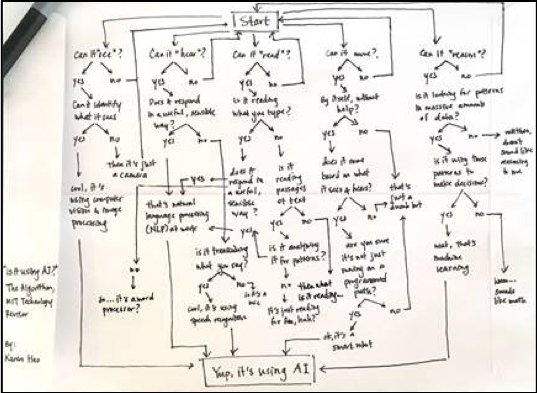A new term continues to dominate the restaurant industry: Artificial Intelligence (AI). It was all the buzz during the National Restaurant Association’s show in Chicago and it continues to come up in countless conversations.

In my quest to understand what AI is, I even asked an academic friend about it. His reply is shown in a process flow chart that was developed. The chart shows a series of questions, each of which lead to other questions, which eventually lead to the conclusion if something is “AI” or not. So, what is “AI”?
As I now understand it, AI represents the application of technology that will provide restaurant operators with functional benefit when running their businesses. It provides them with information (past, present, or future) that will help improve the execution of the operation, that can result in better service, improvement in quality, food safety and/or improvement in operating costs. It could apply to many areas of the restaurant and help simplify the life of operators by telling/suggesting what they need to do, sometimes doing it for them. In some instances, this can happen without the operator having to keep their eyes on a specific task or procedure. But as with most anything, I like to give it a twist, especially when writing about it. You can say that I like to provide a position that will make readers think about their perspectives on the topic. I don’t have to be right, but I do want to provide thought provoking ideas.
Let me give you a few examples of some common examples of AI and others that we may not agree on.
I am going to start with a non-restaurant application that many of us use in our personal lives: Google Maps. You type in an address and as long as you don’t write the wrong address (done by some of us at times), the application suggests the best way to get there based on your settings and dynamically offers suggestions as the traffic changes along the way. I would definitely consider this AI.
In foodservice, there was a recent article of an application of a device in a Domino’s Pizza in Australia The device checked the pizza for accuracy, as the pizza came out of the oven. This dynamic application of AI would improve order accuracy – a key customer benefit – and eliminate the need for an employee to perform this task. The net result is this application should drive sales since it enhances the likelihood customers will receive the right orders.
Another dynamic AI application is a smart workstation that was on display during the NRA Show. The station tracked the movement of an employee’s hands to and from the condiment bins, while the worker assembled the product. This workstation provided guidance to the employee making the item on what goes on the menu item and alerted the individual if they tried to add condiments that did not fit the product specifications.
Another AI example centers on product holding/staging levels. Quick-serve restaurants use levels of finished products (or components) to improve customer service. These levels carefully balance availability vs. waste. The driver for this is an automated system that takes into consideration the sales expected, the product velocity/sales, the quality impact as the product is held. The more sophisticated ones include the cost of wasting the product and the cost of not giving fast service and gives the operator suggested amounts to have pre made. The internal system automatically develops this information by looking at history and the system uses past sales information alongside current sales to predict/suggest what should happen to optimize the hospitality for guests now and in the future. I would call this AI since there is no human work necessary to get this information, it is technology driven and provides a customer and operational benefit to the restaurant operator.
So as you can see, AI can mean different things to different people. You might think that my definition is too broad, especially considering the last example I provided. I would love to hear your definition of what AI is for you.



